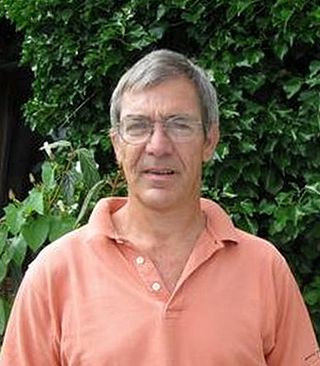
Alexander Grothendieck was a French mathematician who became the leading figure in the creation of modern algebraic geometry. His research extended the scope of the field and added elements of commutative algebra, homological algebra, sheaf theory, and category theory to its foundations, while his so-called "relative" perspective led to revolutionary advances in many areas of pure mathematics. He is considered by many to be the greatest mathematician of the twentieth century.

Pierre René, Viscount Deligne is a Belgian mathematician. He is best known for work on the Weil conjectures, leading to a complete proof in 1973. He is the winner of the 2013 Abel Prize, 2008 Wolf Prize, 1988 Crafoord Prize, and 1978 Fields Medal.

David Bryant Mumford is an American mathematician known for his work in algebraic geometry and then for research into vision and pattern theory. He won the Fields Medal and was a MacArthur Fellow. In 2010 he was awarded the National Medal of Science. He is currently a University Professor Emeritus in the Division of Applied Mathematics at Brown University.
In mathematics, the Jacobian varietyJ(C) of a non-singular algebraic curve C of genus g is the moduli space of degree 0 line bundles. It is the connected component of the identity in the Picard group of C, hence an abelian variety.

Michael Artin is a German-American mathematician and a professor emeritus in the Massachusetts Institute of Technology Mathematics Department, known for his contributions to algebraic geometry.

Yuri Ivanovich Manin was a Russian mathematician, known for work in algebraic geometry and diophantine geometry, and many expository works ranging from mathematical logic to theoretical physics.

In mathematics, arithmetic geometry is roughly the application of techniques from algebraic geometry to problems in number theory. Arithmetic geometry is centered around Diophantine geometry, the study of rational points of algebraic varieties.
In mathematics, a moduli scheme is a moduli space that exists in the category of schemes developed by Alexander Grothendieck. Some important moduli problems of algebraic geometry can be satisfactorily solved by means of scheme theory alone, while others require some extension of the 'geometric object' concept.
This is a glossary of arithmetic and diophantine geometry in mathematics, areas growing out of the traditional study of Diophantine equations to encompass large parts of number theory and algebraic geometry. Much of the theory is in the form of proposed conjectures, which can be related at various levels of generality.

Shou-Wu Zhang is a Chinese-American mathematician known for his work in number theory and arithmetic geometry. He is currently a Professor of Mathematics at Princeton University.
In mathematics, the Schottky problem, named after Friedrich Schottky, is a classical question of algebraic geometry, asking for a characterisation of Jacobian varieties amongst abelian varieties.
Nicholas Ian Shepherd-Barron, FRS, is a British mathematician working in algebraic geometry. He is a professor of mathematics at King's College London.
Anabelian geometry is a theory in number theory which describes the way in which the algebraic fundamental group G of a certain arithmetic variety X, or some related geometric object, can help to restore X. The first results for number fields and their absolute Galois groups were obtained by Jürgen Neukirch, Masatoshi Gündüz Ikeda, Kenkichi Iwasawa, and Kôji Uchida prior to conjectures made about hyperbolic curves over number fields by Alexander Grothendieck. As introduced in Esquisse d'un Programme the latter were about how topological homomorphisms between two arithmetic fundamental groups of two hyperbolic curves over number fields correspond to maps between the curves. These Grothendieck conjectures were partially solved by Hiroaki Nakamura and Akio Tamagawa, while complete proofs were given by Shinichi Mochizuki.
In mathematics, the André–Oort conjecture is a problem in Diophantine geometry, a branch of number theory, that can be seen as a non-abelian analogue of the Manin–Mumford conjecture, which is now a theorem. The conjecture concerns itself with a characterization of the Zariski closure of sets of special points in Shimura varieties. A special case of the conjecture was stated by Yves André in 1989 and a more general statement was conjectured by Frans Oort in 1995. The modern version is a natural generalization of these two conjectures.

René Schoof is a mathematician from the Netherlands who works in number theory, arithmetic geometry, and coding theory.

Dan Abramovich is an Israeli-American mathematician working in the fields of algebraic geometry and arithmetic geometry. As of 2019, he holds the title of L. Herbert Ballou University Professor at Brown University, and he is an Elected Fellow of the American Mathematical Society.
David Arends Gieseker is an American mathematician, specializing in algebraic geometry.

Joseph Henri Maria Steenbrink is a Dutch mathematician, specializing in algebraic geometry.

In mathematics, a Siegel modular variety or Siegel moduli space is an algebraic variety that parametrizes certain types of abelian varieties of a fixed dimension. More precisely, Siegel modular varieties are the moduli spaces of principally polarized abelian varieties of a fixed dimension. They are named after Carl Ludwig Siegel, the 20th-century German number theorist who introduced the varieties in 1943.











